When selecting lye-resistant containers, prioritize HDPE (#2) or PP (#5) materials with thick walls and secure screw-on lids with gaskets. Choose containers with stable bases, adequate volume for splash prevention, and heat dissipation capabilities. Confirm proper labeling with hazard warnings and implement vapor-trapping mechanisms to prevent fume exposure. Don't forget ergonomic features like textured grips for safe handling. These essential safety elements will protect you throughout your soap-making journey.
Material Selection Criteria for Lye-Resistant Containers
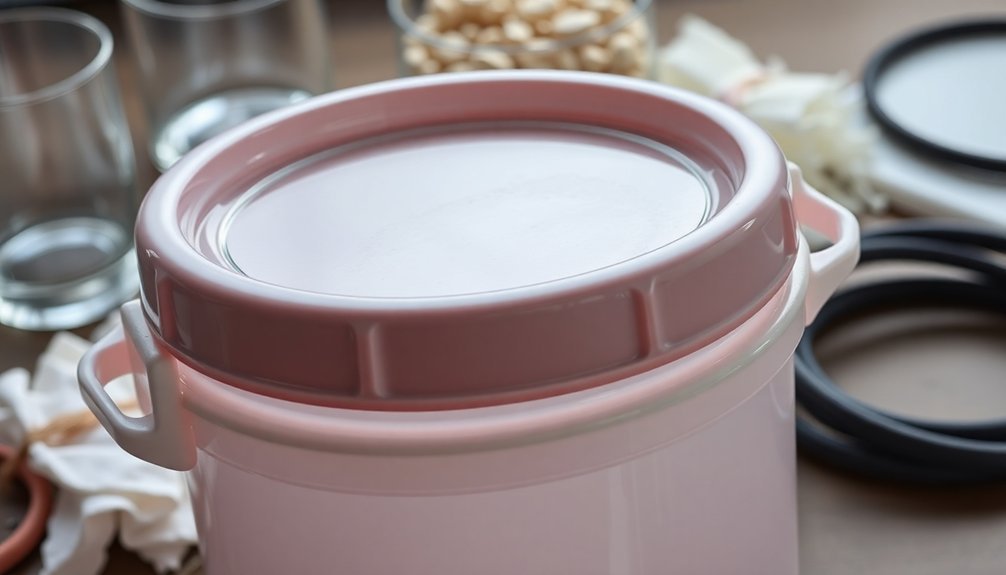
When working with lye solutions, selecting the right container material is essential for both safety and effectiveness.
You'll need containers that can withstand exposure to caustic NaOH and KOH without deteriorating or compromising your safety.
Polypropylene (PP) and High-Density Polyethylene (HDPE) are your best options, as they're specifically resistant to alkali corrosion.
For lye handling, trust PP and HDPE containers—they stand strong against aggressive alkaline solutions while other plastics fail.
Avoid PET and PVC containers, which will break down when exposed to lye. Look for the "green E" symbol on containers, indicating excellent alkali resistance.
Before use, verify the material type rather than guessing—this isn't a place to cut corners.
The container should prevent any chemical reaction with the lye, ensuring no contamination occurs.
Remember that proper material selection is your first defense against potential chemical hazards.
Low density polyethylene (LDPE) offers acceptable resistance but isn't as ideal as HDPE or PP for long-term storage.
Heat Dissipation and Thermal Stability Features
Since lye solutions generate extreme heat during mixing—often reaching temperatures up to 200°F—your container must effectively manage this thermal stress.
Choose heat-resistant materials like polypropylene (PP#5) or stainless steel that won't degrade under thermal fluctuations.
Containers with thick walls and stable bases prevent tipping accidents while accommodating thermal expansion.
Wide-shaped containers dissipate heat more efficiently than tall, narrow ones. You'll get better results by pre-cooling your container or placing it on a cooling surface before mixing.
Consider how thermal shock might affect your container—sudden temperature changes can cause cracking.
Some specialized mixing tanks include temperature control features for consistent results. Incoloy 800 sheath on heating elements provides exceptional durability against the corrosive nature of lye solutions.
Remember that proper heat management isn't just about container integrity—it's essential for your safety to prevent burns and chemical exposure.
Protective Sealing and Lid Mechanisms
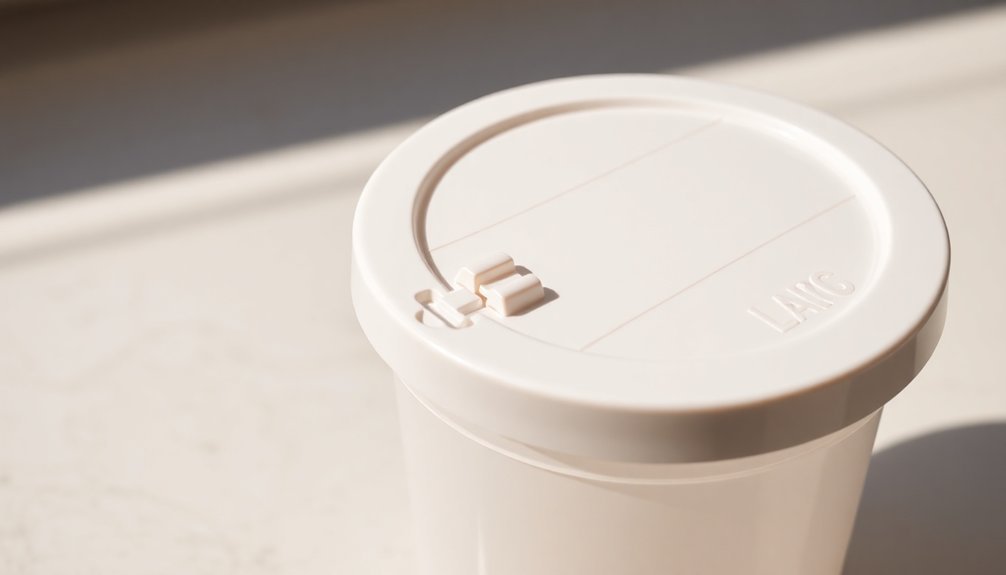
When working with caustic lye solutions, you'll need containers with secure lid clasps that prevent accidental spills during transportation or storage.
Screw-on lids with rubber gaskets provide superior protection compared to snap-on varieties, creating a tight, chemically resistant seal that withstands the corrosive nature of lye.
Vapor-trapping designs further enhance safety by containing potentially harmful fumes, making regular inspection of these sealing mechanisms essential to maintain their integrity over time. Always wear lye-resistant gloves when handling these containers to prevent potential skin burns if accidental contact occurs.
Secure Lid Clasps
The effectiveness of any lye-resistant container ultimately depends on its sealing mechanism.
You'll want to prioritize screw-on caps over snap-on lids, as they provide superior security against leaks during handling and storage.
Before using your container with lye, test its seal by filling it with water and turning it upside down.
Check that the screw threads are high-quality and undamaged.
HDPE (#2) and PP (#5) plastics offer the best chemical resistance for both container bodies and lid materials.
Avoid containers made with aluminum lids or components as they can be completely destroyed by lye solutions.
Regularly inspect your lid's seal for wear or damage, especially after repeated use.
The closure material must be compatible with lye's caustic properties.
Remember that proper lid security isn't just about preventing messes—it's about protecting yourself and others from potentially dangerous chemical exposure.
Vapor-Trapping Designs
Effective vapor-trapping designs offer critical protection when working with lye solutions, preventing caustic fumes from escaping into your workspace.
Look for containers featuring diaphragm valves that prevent vapor backflow and specialized carbon filters that trap harmful VOCs.
Your safest options incorporate EPDM gaskets or silicone seals with multiple port configurations for filter attachments.
Choose caps with straight or 90-degree adapters that optimize filter positioning while maintaining an airtight seal.
The most effective systems use closed designs that minimize air exposure altogether.
For maximum protection, select containers with filter saturation indicators that signal when replacement is necessary.
Guarantee any unused ports are securely plugged and verify your container materials (HDPE or PP) offer appropriate chemical resistance for lye storage.
Regular maintenance of these vapor-trapping components is essential for continuous safety.
Premium stainless steel lids, like those on industrial lye tanks, provide a reliable vapor seal that maintains solution strength for extended periods of time.
Ergonomic Design for Safe Handling
Proper ergonomic design plays an essential role in ensuring safe handling of lye-resistant containers during soap-making operations. When selecting containers, prioritize those with sturdy construction that won't flex or deform while you're pouring or mixing.
Look for containers featuring textured or rounded edges that provide a secure grip, especially when your hands might be slippery. The weight should be evenly distributed to prevent strain during extended use.
Screw-on lids are preferable to snap-on varieties, as they create more reliable seals and reduce spill risks. Non-slip surfaces on container bottoms offer additional stability during mixing operations.
For maximum safety and convenience, choose containers that are lightweight enough for comfortable handling but substantial enough to remain stable on your work surface. For lye solutions, always use containers made of PP #5 or HDPE #2 plastic as they resist chemical reactions and maintain their integrity at high temperatures.
Volume Capacity and Splash Prevention
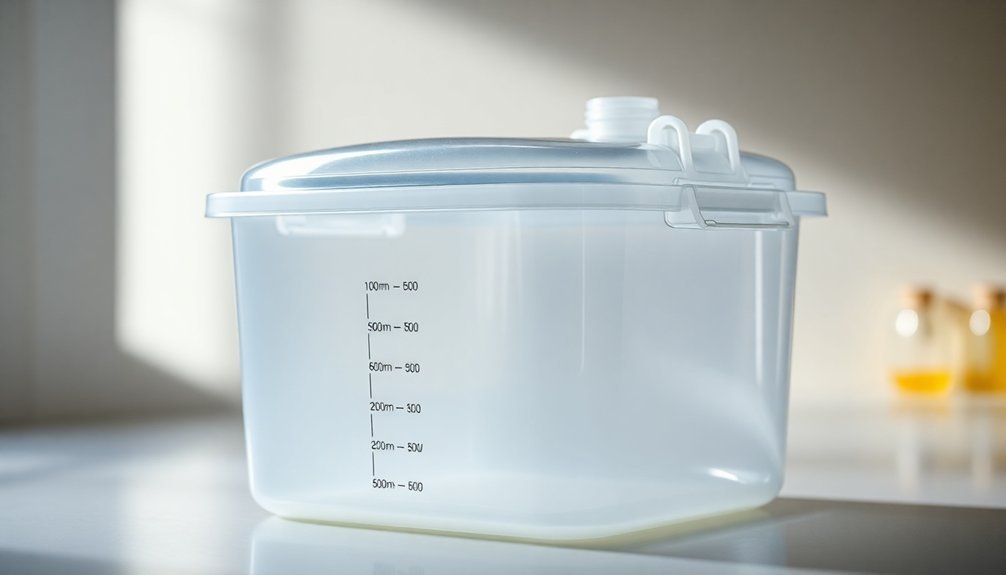
Beyond ergonomic design features, selecting containers with appropriate volume capacity and splash prevention mechanisms represents a fundamental safety consideration for soap makers.
Choose vessels that accommodate your batch sizes while accounting for the increased density of lye solutions, which weigh up to 1.5 times more than water.
Prioritize containers with secure, leak-proof lids and integrated splash guards to minimize exposure risks during mixing and pouring.
Place your mixing station on non-slip surfaces and surround it with absorbent materials to contain potential spills.
For maximum safety, verify your workspace is well-ventilated to reduce fume inhalation.
When evaluating containers, select those made from HDPE or PP plastics that resist alkali degradation.
Avoid PET and PVC materials, which quickly deteriorate when exposed to strong bases like sodium hydroxide.
Chemical Reaction Resistance Properties
Understanding chemical reaction resistance properties stands at the core of safe soapmaking when working with lye. You'll need containers specifically designed to withstand lye's caustic nature without degrading or creating dangerous reactions. Proper selection of containers is vital since sodium hydroxide lye can cause severe burns to skin upon contact.
| Material | Lye Resistance | Temperature Tolerance | Safety Features | Best For |
|---|---|---|---|---|
| HDPE | Excellent | Up to 120°C | Non-reactive | Long-term storage |
| LDPE | Very good | Up to 80°C | Flexible | Mixing solutions |
| Glass | Excellent | High | Transparent | Viewing reactions |
| Stainless Steel | Good | Very high | Durable | Production scale |
| PET | Limited | Low-medium | Lightweight | Temporary use only |
Never use aluminum or tin containers as they'll react violently with lye, producing dangerous hydrogen gas. Remember that chemical resistance decreases at higher temperatures, so always consider both the material and your working conditions.
Durability and Structural Integrity Considerations
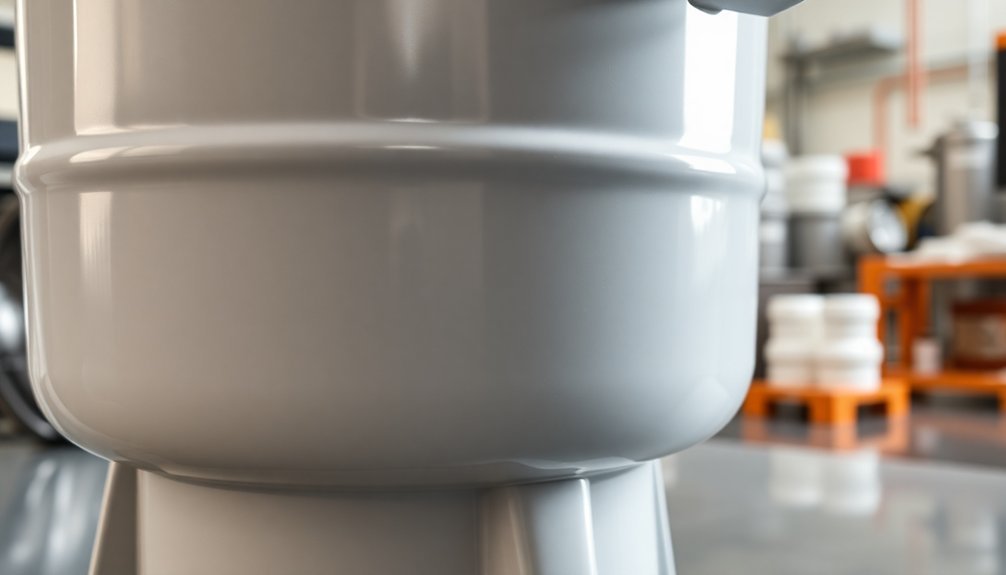
When selecting containers for lye handling, durability and structural integrity become essential safety factors that directly impact your soapmaking success. Your container must withstand both the caustic nature of lye and the weight of solutions that can be 1.5 times heavier than water.
- Thick-walled containers – Choose HDPE or PP plastics with substantial thickness to prevent flexing or potential collapse during mixing.
- Secure closure systems – Opt for screw-on caps rather than snap lids to eliminate leakage risks.
- Proper sizing – Select containers with adequate volume to handle splashes and mixing without overflow.
- Stable base design – Guarantee your container has a wide, flat bottom that won't tip over during the mixing process.
Labeling and Safety Marking Requirements
The proper labeling of your lye containers isn't just good practice—it's a critical safety measure that protects everyone who might come into contact with these caustic materials. Always mark containers with "LYE" or "POISON" along with appropriate hazard symbols. Clear labeling is essential to prevent accidental contact with potentially harmful substances.
| Label Element | Requirement | Why It Matters |
|---|---|---|
| Warning Text | "LYE" or "POISON" | Prevents accidental ingestion |
| Material Code | HDPE (#2) or PP (#5) | Guarantees chemical resistance |
| Regulatory Info | FDA/MSDS compliance | Meets legal standards |
Your containers should use HDPE (#2) or PP (#5) plastics, marked with an "E" rating for chemical resistance. Keep all lye solutions in areas inaccessible to children and pets, and maintain proper signage wherever lye is stored. Regularly inspect your labels for wear and verify they remain legible for the container's entire lifespan.
Ventilation and Fume Management Systems
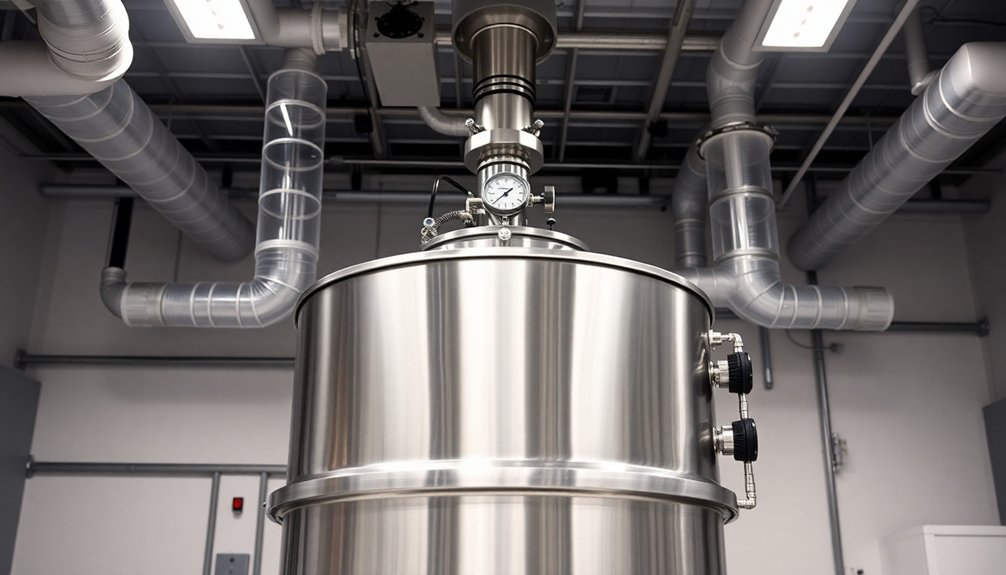
Proper ventilation serves as your first line of defense against dangerous lye fumes during mixing operations.
When handling lye, you'll need both natural and mechanical ventilation to disperse harmful vapors effectively. Whenever possible, mix lye outdoors where natural air circulation provides maximum protection.
For indoor mixing, implement these essential safeguards:
- Combined ventilation systems – Integrate fans with extraction systems to quickly remove fumes from your workspace.
- Container management – Use properly sized containers with tight-fitting lids to minimize fume escape.
- Workspace separation – Keep lye mixing areas completely isolated from living spaces.
- Contingency planning – Install backup ventilation systems and always have respiratory protection ready in case primary systems fail.
Regular inspection of your ventilation equipment guarantees continuous protection against harmful fume exposure. Always add lye to water, never water to lye, to prevent dangerous splashing that can cause severe burns and increase fume release.
Cleaning and Maintenance Best Practices
To properly neutralize lye residue on your mixing containers, you'll need a vinegar solution that safely counters the alkaline nature of lye before washing with regular soap.
Keep your containers in top condition by inspecting them regularly for cracks, discoloration, or warping that might compromise their lye resistance. Using appropriate mixing containers like glass, heat-resistant plastic, or stainless steel is essential, while avoiding tin or aluminum which can react with lye.
Dedicated cleaning tools like non-abrasive brushes and microfiber cloths will extend your containers' lifespan while ensuring no dangerous residue remains after each soap-making session.
Neutralizing Lye Residue
When working with lye in mixing containers, effective cleaning and neutralization become essential safety measures to prevent accidental chemical burns and container damage.
Always neutralize residual lye before cleaning to guarantee safe handling and proper container maintenance.
- Neutralize with acid – Use vinegar or diluted muriatic acid to counteract any remaining lye, adding slowly while monitoring the pH until it reaches 6-7.
- Monitor temperature – Neutralization reactions generate heat, so work slowly and in a well-ventilated area to prevent overheating.
- Rinse thoroughly – After neutralization, rinse containers multiple times with water to remove all chemical residues.
- Test before reuse – Verify complete neutralization with pH testing strips before storing containers or using them with other ingredients.
Tools For Container Care
Long-term success with lye containers depends on your diligence in cleaning and maintenance routines.
After each use, thoroughly clean containers with soap and water to remove all residue that could cause future lye reactivation. Dry them completely to prevent mineral deposits.
You'll need gentle scouring pads that won't damage container surfaces, particularly for HDPE or PP materials.
Inspect your containers regularly for cracks, chemical damage, or seal issues. Look closely at lid alignment to guarantee proper sealing.
Store your clean containers in cool, dry locations away from children and pets.
Maintain a dedicated space for soap-making equipment to prevent cross-contamination.
Remember to label containers clearly, even when empty, so they're never mistakenly used for other purposes that could compromise their integrity.
Storage Solutions for Lye Containers
Three critical factors determine the safety and effectiveness of lye storage: proper container materials, secure storage location, and clear labeling.
When selecting storage solutions for your lye containers, prioritize HDPE#2 or PP#5 plastic containers with tight-sealing lids to prevent moisture absorption and leakage.
- Dedicated Storage Area – Keep containers in a cool, dry place away from children, pets, and food items, preferably in a locked cabinet or high shelf.
- Container Positioning – Store containers upright to prevent accidental leaks with spill containment trays beneath them.
- Ventilation Requirements – Guarantee your storage area has adequate airflow to prevent fume buildup.
- Inspection Schedule – Regularly check containers for signs of deterioration, leaks, or lid integrity issues.
Frequently Asked Questions
Can I Use Ceramic Containers for Mixing Lye Solutions?
Yes, you can use ceramic containers for mixing lye solutions since they're resistant to chemical reactions with NaOH or KOH. Just make certain they're heat-resistant and free of cracks that could lead to dangerous leaks.
How Long Does a Typical Lye-Resistant Container Last Before Replacement?
Your high-quality lye-resistant containers (polypropylene or HDPE) can last 3-5 years with proper care. You'll need to replace them sooner if you notice cracks, discoloration, softening, or decreased rigidity during regular inspections.
Are There Portable Lye Containers Suitable for Outdoor Soap Making?
Yes, you'll find portable options in PP #5 containers with tight-fitting lids, durable stainless steel buckets, and PVC containers. They're lightweight, easy to transport, and perfect for outdoor soap making sessions.
Can Temperature Indicators Be Installed on Existing Containers?
Yes, you can easily install temperature indicators on your existing containers. They're self-adhesive, require no special tools, and won't damage container integrity. Just verify the surface is clean and dry before application.
How Do Different Water Hardness Levels Affect Container Selection?
Water hardness impacts your container choice considerably. You'll need stainless steel for hard water areas to prevent scaling, while softer water requires corrosion-resistant materials. Glass works well across all hardness levels for chemical stability.
In Summary
You'll extend the lifespan of your equipment and protect yourself by investing in properly designed lye-resistant containers. Remember to prioritize safety features like proper sealing, thermal stability, and adequate ventilation. Don't compromise on material quality or ergonomic design. When you maintain and store your containers correctly, you'll create a safer mixing environment for all your caustic substance projects.





Leave a Reply